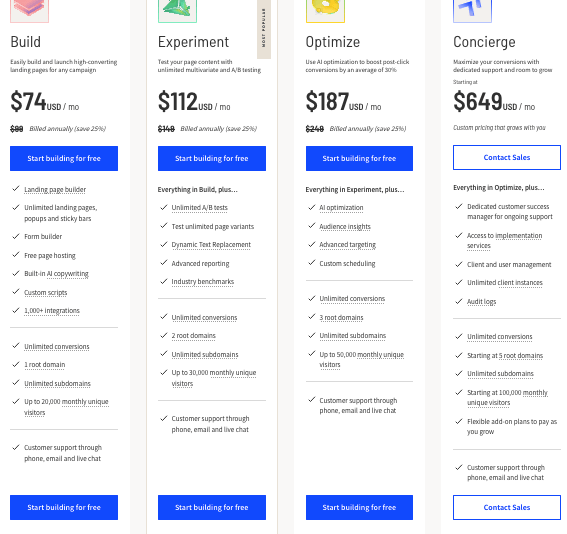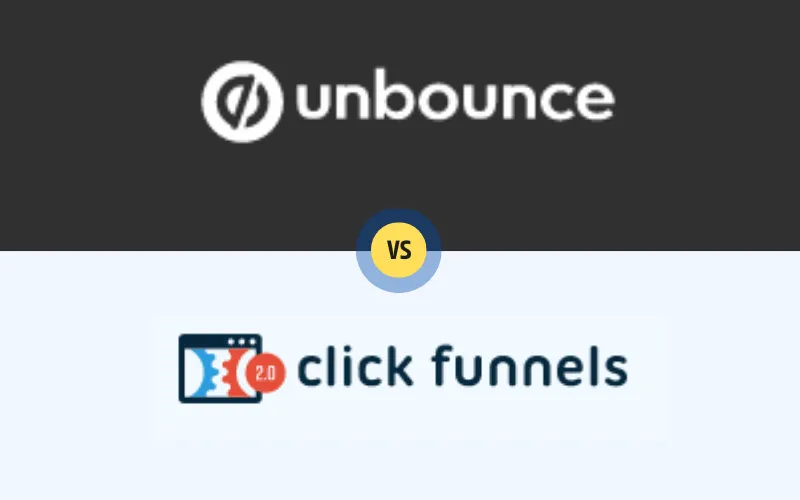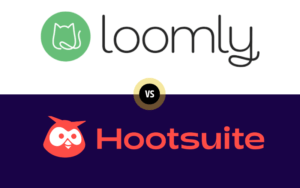Unbounce vs ClickFunnels—which landing page builder will set your business apart in 2024? In the digital marketing arena, the right tools are more than just helpful; they’re a cornerstone of successful strategies. Both Unbounce and ClickFunnels offer promising features designed to streamline your campaigns and maximize conversions, but which one truly fits your unique business needs? This comparative analysis will guide you through their key features, user experiences, and pricing models, culminating in a verdict that aims to clear your doubts.
As we peel back the layers of each service, you’ll gain valuable insights to determine which tool could elevate your marketing efforts and enhance your online presence effectively. Prepare to discover the definitive choice for your business as we evaluate the pros and cons of these industry-leading platforms.
Table of Contents
Quick Comparison: Unbounce vs ClickFunnels
When evaluating Unbounce vs ClickFunnels, it’s crucial to quickly identify which tool might best meet your needs without diving deep into every detail. For those in a hurry, here’s a concise breakdown comparing the core aspects of Unbounce and ClickFunnels.
Ease of Use
Unbounce is renowned for its straightforward, drag-and-drop interface that allows marketers to create custom landing pages without any coding knowledge. Its intuitive design ensures that new users can start building and publishing pages almost immediately.
ClickFunnels, on the other hand, not only focuses on landing pages but also offers a wide array of funnel functionalities, which can be slightly more complex to navigate for beginners. However, it provides extensive training materials and templates to help users get started.
Feature Set
Unbounce excels in providing a wide range of customizable templates and the flexibility to tweak every element of a landing page. Additionally, its A/B testing capabilities are robust, making it ideal for marketers focused on optimizing conversion rates.
ClickFunnels offers a comprehensive suite of tools that assist in creating entire sales funnels, not just single pages. This includes email autoresponders, payment processing integrations, and webinar setups, making it a more versatile tool for extensive marketing campaigns.
Performance Unbounce vs ClickFunnels
Both platforms are designed to handle high traffic efficiently, ensuring that your campaigns run smoothly without interruptions. Unbounce may have a slight edge in loading times due to its lighter pages, while ClickFunnels is optimized for a seamless flow through the entire sales funnel.
Initial Verdict
For individuals focused solely on creating and testing landing pages, Unbounce might be the preferable choice due to its specialized tools and ease of use. Meanwhile, ClickFunnels is potentially more beneficial for marketers looking to manage comprehensive funnels that encompass various stages of the customer journey.
This quick comparison of Unbounce vs ClickFunnels highlights the primary differences to help you lean towards the tool that best aligns with your marketing needs.
Features Unbounce vs ClickFunnels
Diving deeper into Unbounce vs ClickFunnels, we compare the specific features each platform offers. This detailed analysis will help you understand the distinct advantages each tool provides, catering to various aspects of online marketing and sales funnel management.
Landing Page Design and Templates
Unbounce shines with its extensive library of templates and the highly flexible drag-and-drop editor. It allows for precise control over page design, enabling marketers to create unique and optimized landing pages without needing any coding skills. The platform also supports custom HTML, CSS, and JavaScript, offering endless customization possibilities.
ClickFunnels, while also providing a range of templates, focuses more on the functionality of complete sales funnels. Each template is designed not just as a standalone page but as part of an integrated campaign to guide visitors through different stages of the sales process. This makes it ideal for users who need a comprehensive solution that goes beyond just landing pages.
A/B Testing and Conversion Tools
Unbounce offers robust A/B testing capabilities, allowing users to test different versions of their pages to see which performs better in real-time. This feature is crucial for optimizing conversion rates and is enhanced by dynamic text replacement, which personalizes content based on search terms used by visitors.
ClickFunnels integrates A/B testing within its funnel approach, enabling testing not only of landing pages but also of different paths within the funnel. This holistic testing is vital for optimizing entire marketing and sales strategies, although it might be more complex to set up compared to Unbounce’s straightforward approach.
Integrations and APIs
Unbounce integrates smoothly with numerous marketing tools and services, including email marketing platforms, analytics tools, and webinar services, facilitating a seamless workflow. Its API also allows for deeper integration with custom and third-party tools, enhancing its versatility.
ClickFunnels excels in the breadth of its integrations, particularly with payment gateways and membership systems, which are essential for businesses that sell products and services directly through their funnels. The platform’s API provides additional flexibility, though its primary strength lies in the seamless integration of all components of the sales funnel.
User Support and Community
Both platforms boast active communities and comprehensive support systems. Unbounce offers detailed documentation, a responsive customer support team, and a community forum where users can exchange tips and advice. ClickFunnels has a similarly strong support network, including official forums, extensive training materials, and live support options.
In comparing Unbounce vs ClickFunnels, it’s clear that each has its strengths tailored to specific needs: Unbounce excels in detailed landing page design and optimization, while ClickFunnels offers comprehensive solutions for building and managing entire sales funnels. Depending on your specific marketing goals, one may suit your needs better than the other.
Personal Experience
In this section, we explore first-hand insights on Unbounce vs ClickFunnels. Sharing personal experiences can provide a practical perspective on how each platform operates in real-world scenarios, helping you make an informed decision based on user experiences beyond just feature lists.
Ease of Setup and Usability
My journey with Unbounce began with its quick setup process. I appreciated the straightforward interface, which made it easy to get started without any prior training. The drag-and-drop functionality was intuitive, allowing me to design landing pages that were both beautiful and functional in no time. This ease of use is a significant advantage for those who want to launch campaigns quickly and efficiently.
Switching to ClickFunnels, the initial setup felt more involved due to the complexity of its features. However, once I navigated through its learning curve, the power of its all-in-one funnel approach became evident. ClickFunnels excels in creating a series of interconnected pages and automations that guide visitors through the conversion process seamlessly.
Real-World Application and Flexibility
Using Unbounce, I found the flexibility in design to be incredibly beneficial for A/B testing. Adjusting elements on the fly to test different approaches helped optimize my landing pages for better conversion rates. The platform’s focus on landing pages meant I could fine-tune each page to meet specific campaign goals without distraction.
With ClickFunnels, the real-world application extended beyond landing pages. It was invaluable for creating comprehensive marketing funnels. The ability to integrate with multiple third-party apps and services without hassle meant I could set up a complete sales funnel, including email campaigns and payment processing, all within the same ecosystem.
Performance and Outcome
In terms of performance, Unbounce pages loaded quickly and performed well, even under heavy traffic, which is crucial for high-stakes campaigns. The analytics tools provided were powerful and user-friendly, making it easy to track performance and make data-driven decisions.
ClickFunnels also performed admirably, with the added benefit of managing entire customer journeys. The integration of various funnel stages into a single flow was a game-changer, making it easier to track conversions from start to finish and identify bottlenecks in the funnel.
Overall Satisfaction
My overall experience with Unbounce was extremely positive, particularly for projects where the primary goal was lead generation through tailored landing pages. Its specialized tools made it ideal for these purposes.
ClickFunnels offered a more robust solution when my needs extended to managing comprehensive sales processes. It was particularly useful when I needed to implement a series of marketing actions leading to a final sale, making it a vital tool for complete digital marketing strategies.
In summary, the choice between Unbounce vs ClickFunnels largely depends on your specific needs—whether you require a focused landing page builder or a comprehensive sales funnel solution. Both platforms have their merits, and the decision should align with your marketing objectives and operational style.
Pricing
Unbounce and ClickFunnels offer different pricing tiers suitable for various business sizes and needs. Understanding these can help you determine which provides better value for your marketing strategy.
Unbounce Pricing Plans

- Build Plan: $99 monthly or $74 per month when billed annually, includes unlimited landing pages, popups, sticky bars, and up to 20,000 monthly visitors.
- Experiment Plan: $149 monthly or $112 per month annually, adds unlimited A/B tests and up to 30,000 visitors.
- Optimize Plan: $249 monthly or $187 per month annually, incorporates AI optimization and up to 50,000 visitors.
- Concierge Plan: Starts at $649 monthly, offers dedicated support and begins at 100,000 visitors.
ClickFunnels Pricing Plans

- Basic: $127 per month (billed annually), includes 1 website, 20 funnels, 3 users, 1 domain, 10,000 contacts, unlimited courses, pages, products, and email sequences.
- Pro: $157 per month (billed annually), increases capabilities to 100 funnels, 5 users, 3 domains, 25,000 contacts, and adds API access.
- Funnel Hacker: $208 per month (billed annually), expands further with 3 websites, unlimited funnels, 15 users, 9 domains, and up to 200,000 contacts.
Cost-Effectiveness
Unbounce is ideal for users primarily focused on landing pages, offering a more accessible starting price. ClickFunnels, with its comprehensive funnel-building capabilities, provides extensive tools suitable for larger or more complex online business operations, reflected in its higher pricing tiers.
By evaluating your specific marketing goals and budget, you can choose the platform that offers the most appropriate features and best overall value for your business needs.
Pros & Cons
When comparing Unbounce vs ClickFunnels, it’s essential to weigh the advantages and disadvantages of each platform to understand how they align with different business needs.
Advantages of Unbounce
Unbounce excels in providing a user-friendly platform focused primarily on landing pages. It offers:
- High Customization: Extensive options for customizing landing pages to fit the specific branding and conversion goals of a business.
- Ease of Use: The drag-and-drop editor makes it simple for non-technical users to create and optimize pages.
- Dedicated Landing Page Focus: Specialized features like dynamic text replacement and powerful A/B testing tools cater specifically to optimizing landing page performance.
Disadvantages of Unbounce
Despite its strengths, Unbounce has some limitations:
- Limited Scope: Primarily focused on landing pages without native sales funnel creation capabilities.
- Visitor Caps: Each plan comes with a cap on the number of visitors, which can be limiting for high-traffic campaigns.
Advantages of ClickFunnels
ClickFunnels offers a broader set of tools designed for building complete sales funnels:
- All-in-One Solution: Integrates tools for email marketing, payment gateways, and membership sites, making it ideal for managing an entire sales process.
- Funnel Templates: Provides a variety of pre-built funnel templates that help users quickly start with proven structures.
- Extensive Integrations: Seamless integration with various third-party applications enhances its utility for comprehensive marketing strategies.
Disadvantages of ClickFunnels
However, ClickFunnels is not without its drawbacks:
- Complexity: The wide array of features can be overwhelming for beginners or small projects that don’t require complex funnels.
- Cost: Generally more expensive than Unbounce, especially at higher tiers which provide more advanced features.
Understanding these pros and cons in the context of Unbounce vs ClickFunnels can help you decide which platform better suits your business’s online marketing strategies.
Alternatives
When considering Unbounce vs ClickFunnels, it’s also useful to explore other tools in the market that might better fit specific needs or budgets. Here we look at some popular alternatives.
Leadpages
Leadpages is a strong contender, especially for small businesses looking for cost-effective solutions. It offers:
- Ease of Use: Similar to Unbounce, it provides a drag-and-drop interface.
- Lower Cost: Generally less expensive than both Unbounce and ClickFunnels, making it accessible for startups.
Instapage
Instapage is another powerful alternative known for:
- Advanced Features: Offers unique features like heatmaps and detailed analytics.
- High Customization: Allows for highly customized designs which can compete with Unbounce’s capabilities.
Builderall
Builderall targets users who need an all-in-one solution without the higher cost of ClickFunnels:
- Multiple Tools: Includes a website builder, email marketing automation, and more.
- Affordability: More budget-friendly than ClickFunnels with a broad set of features.
HubSpot Landing Pages
HubSpot Landing Pages integrate deeply with its CRM, ideal for those already using HubSpot’s marketing suite:
- Integration: Seamless integration with other HubSpot tools.
- Data Synchronization: Excellent for managing comprehensive campaigns that benefit from CRM data insights.
Each of these alternatives offers unique advantages and might be preferable depending on your specific requirements, such as budget constraints, the need for advanced analytics, or integration with other marketing tools.
Use Cases
In comparing Unbounce vs ClickFunnels, it’s valuable to consider specific use cases that highlight the strengths and applicabilities of each platform.
Small Business and Startups
For small businesses or startups focusing on building and testing landing pages quickly:
- Unbounce is ideal due to its ease of use, affordability, and strong A/B testing capabilities, which allow for rapid optimization based on user feedback.
E-Commerce and Online Stores
For e-commerce businesses that need a comprehensive tool to manage everything from landing pages to payment processing:
- ClickFunnels offers extensive features that support the entire sales process, making it suitable for businesses looking to implement complex sales funnels that convert visitors into buyers.
Agencies and Marketing Firms
Agencies requiring versatile tools to handle multiple client projects might prefer:
- Unbounce for its superior landing page design and optimization capabilities.
- ClickFunnels for its ability to manage complete sales funnels, which is beneficial when dealing with diverse client needs.
Content and Course Creators
For individuals or companies that focus on content creation and courses:
- ClickFunnels provides excellent tools for managing courses, memberships, and engagement through integrated funnels that maintain user interest and encourage purchases.
Each platform serves well in its respective strengths, and the choice between Unbounce vs ClickFunnels should align with your specific business goals and operational demands.
Who is the Winner?
In the comparison of Unbounce vs ClickFunnels, the choice of the better platform ultimately depends on your specific marketing needs and business goals.
Deciding Factors
- Unbounce is the preferred option for businesses that need a powerful, user-friendly tool primarily for creating and optimizing landing pages. Its ease of use, detailed A/B testing, and focus on maximizing page performance make it ideal for marketers who want to quickly deploy and refine their landing pages.
- ClickFunnels excels for enterprises or marketers that require an all-encompassing solution for building complex sales funnels that cover everything from lead capture to sales conversions. Its extensive features support a wide array of functionalities, including email sequences, payment integrations, and course management, which are crucial for comprehensive digital marketing strategies.
Final Verdict
If your priority is specialized landing page creation and testing, Unbounce is likely the better choice. However, if you need a robust platform that supports the creation and management of entire sales funnels, ClickFunnels provides the necessary tools and integrations to manage complex marketing campaigns effectively.
This summary should help guide your decision on which tool will best serve your marketing objectives, enhancing both your workflow and outcomes.
FAQs: Unbounce vs ClickFunnels
1. Which platform is better for beginners?
Unbounce is generally more user-friendly for beginners due to its intuitive drag-and-drop interface, making it ideal for those new to creating landing pages.
2. Can ClickFunnels replace my entire marketing suite?
Yes, ClickFunnels can potentially replace multiple tools in your marketing suite as it offers comprehensive features that cover various aspects of online marketing and sales processes.
3. Is Unbounce suitable for large businesses?
Unbounce is highly scalable and can support large businesses, especially with its higher-tier plans which allow for increased visitor capacities and advanced features.
4. How does pricing compare between Unbounce and ClickFunnels?
Unbounce offers a more affordable entry point, whereas ClickFunnels, although more expensive, provides a broader range of features and capabilities, making it suitable for comprehensive marketing strategies.
5. Can I integrate other tools with these platforms?
Both platforms offer robust integration options. Unbounce integrates well with other marketing tools, enhancing its landing page capabilities, while ClickFunnels offers integrations that support an entire sales funnel management ecosystem.
6. Which platform offers better support and resources?
Both Unbounce and ClickFunnels provide excellent customer support and online resources, including community forums, tutorials, and extensive documentation.
Explore More
Curious about other marketing tools and how they stack up? Check out more insightful articles and comparisons at our Marketing Tools Blog to stay ahead in your digital marketing game!





